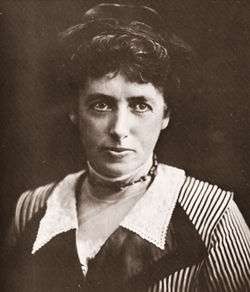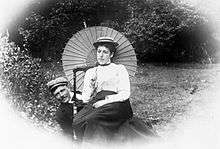Frances Hodgkins

Frances Mary Hodgkins (28 April 1869 – 13 May 1947) was a painter chiefly of landscape and still life, and for a short period was a designer of textiles. She was born in New Zealand, but spent most of her working life in Britain. She is considered one of New Zealand's most prestigious and influential painters, although it is the work from her life in Europe, rather than her home country, on which her reputation rests.[1]
Life
Hodgkins was born in Dunedin, New Zealand in 1869, the daughter of W. M. Hodgkins, a lawyer, amateur painter, and a leading figure in the city's art circles.[2]
As a girl she attended Braemar House, a private girls' secondary school.[2] She first exhibited in 1890, although she felt overshadowed by her sister, Isabel. In 1893 she became a student of Girolamo Nerli who inspired her first successes.[3] It has been suggested this is where she first met Dorothy Kate Richmond (1860–1935). In 1895–96 she attended the Dunedin School of Art. Her watercolor painting won early recognition.
In 1901 she left New Zealand for Europe, travelling to Britain but also visiting France, the Netherlands, Italy and Morocco in the company of Dorothy Kate Richmond; whom she described as "the dearest woman with the most beautiful face and expression. I am a lucky beggar to have her as a travelling companion."[4] While in Britain she intermittently met up with Margaret Stoddart, another expatiate artist.[5]
She returned to New Zealand and established a studio in Wellington, where she held a joint exhibition with Richmond in 1904. Among her pupils was Edith Kate Bendall, lover of Katherine Mansfield. In the same year Hodgkins became engaged to a British man, T. Boughton Wilby, after the briefest of courtships. She planned to go overseas to marry him, but the engagement was broken off at the last moment for unknown reasons.

In 1906, dissatisfied with teaching in New Zealand, Hodgkins returned to London. Her first solo show was in London in 1907.
In 1911–12 she taught in Paris at Colarossi's academy, the first woman to be appointed instructor in the school.[6] During this time she came in contact with Canadian artist, Emily Carr, whom she taught while working on seascapes at Concarneau in Brittany.
During World War I she spent some time in Zennor, Cornwall, where she worked with the Swansea painter, Cedric Morris, who painted her portrait in 1917.[7] She herself began to paint in oils in 1915.
In 1919, after the War, she went to France, where she was influenced by Matisse and Derain, but developed her own highly personal style, which made a strong impact at her first one-person show in London at the Claridge Gallery in 1928. While in France she visited Nice in 1924 and there met Margaret Mary Butler, a notable New Zealand sculptor.[8]
From the late 1920s she began to develop her own style, characterised by strong use of colour and lyrical treatment of form. In 1929 she joined the Seven and Five Society and worked alongside younger artists including Barbara Hepworth, Ben Nicholson and Henry Moore. In 1930, it is said, she was the person who finally "goaded" her friend Lucy Wertheim into opening her gallery in London to exhibit "artists who had not yet arrived".[9] During the 1930s Hodgkins exhibited with many important London galleries and gained a contract from the Lefevre Gallery to produce work for a full-scale exhibition every second year. In 1931 she became a painting companion of fellow New Zealand artist Maude Burge and painted still lifes at Burge's Villa in the garden terrace. Saint-Tropez.[10] In 1939 she was invited to represent Britain at the 1940 Venice Biennale, but wartime travel restrictions meant that her work could not be transported to Venice.[11] She was highly considered among British avant-garde society and by the later stages of her career was known as a key figure in British Modernism.[12]
Because of World War II she spent the rest of her life in Britain. She continued to paint into her seventies, despite suffering from rheumatism and bronchitis. She died in Dorchester, Dorset on 13 May 1947. When she died she was regarded as one of Britain’s leading artists.[11] In 1948 Myfanwy Evans (later Piper) wrote a study entitled Frances Hodgkins, as part of the 'Penguin Modern Painters' series.
Frances Hodgkins is most admired for the freely painted works of her later life. She is an artistic descendant of Henri Matisse and a lyrical colourist.
Fellowship
The Frances Hodgkins Fellowship, established in 1962 at the University of Otago in Dunedin, New Zealand, is named after her.
Works in collections
Notes
- ↑ "Auckland City Art Gallery : Paintings and Drawings by Frances Hodgkins" (PDF). Aucklandartgallery.com. Retrieved 17 November 2013.
- 1 2 Gill, Linda. "Hodgkins, Frances Mary". Dictionary of New Zealand Biography. Ministry for Culture and Heritage. Retrieved 17 November 2013.
- ↑ Entwisle 1984, pp. 133–135.
- ↑ Archived 25 December 2005 at the Wayback Machine.
- ↑ Dawson, Bee (1999). Lady painters : the flower painters of early New Zealand. Auckland, New Zealand: Viking. p. 119. ISBN 0670886513.
- ↑ "Biography of Frances Hodgkins". Museum of New Zealand Te Papa Tongarewa. Retrieved 17 December 2013.
- ↑ "Sir Cedric Morris, Bt". Tate. Retrieved 17 November 2013.
- ↑ Stocker, Mark. "Margaret Mary Butler". Dictionary of New Zealand Biography. Ministry for Culture and Heritage. Retrieved December 2011. Check date values in:
|access-date=(help) - ↑ "Mrs Lucy Wertheim Ecouraging Young Artists". The Times. London. 15 December 1971.
- ↑ http://nzetc.victoria.ac.nz/tm/scholarly/tei-PlaNine-t1-body-d1-d201.html
- 1 2 Museum of New Zealand Te Papa Tongarewa. "Biography of Frances Hodgkins - Collections Online - Museum of New Zealand Te Papa Tongarewa". Collections.tepapa.govt.nz. Retrieved 17 November 2013.
- ↑ Archived 27 September 2011 at the Wayback Machine.
References
- Entwisle, Peter (1984). "Frances Mary Hodgkins 1869–1947". William Mathew Hodgkins & his Circle. Dunedin: Dunedin Public Art Gallery. ISBN 9780473002633. OCLC 13361258.
Further reading
- The Expatriate, a biography by E. H. McCormick (1954, New Zealand University Press, Wellington)
- Frances Hodgkins: a private viewing by Joanne Drayton (2005, Godwit, Auckland) ISBN 1-86962-117-4
- Orford, Emily-Jane Hills. (2008). "The Creative Spirit: Stories of 20th Century Artists". Ottawa: Baico Publishing. ISBN 978-1-897449-18-9
- Women and the Arts in New Zealand. Forty Works: 1936-86 by Elizabeth Eastmond and Merimeri Penfold (1986, Penguin Books) ISBN 978-0140092349
- Frances Hodgkins: Paintings and Drawings by Iain Buchanan, Michael Dunn and Elizabeth Eastmond (2002, Auckland University Press) ISBN 978-1869402631
External links
| Wikimedia Commons has media related to Frances Hodgkins. |
- 19 Paintings by Frances Hodgkins at the Art UK site
- Biography in 1966 An Encyclopaedia of New Zealand
- Notes by Una Platts
- New Zealand exhibition catalogue
- Tate: Frances Hodgkins
- Auckland Art Gallery Toi o Tāmaki: Works by Frances Hodgkins
- Museum of New Zealand Te Papa Tongarewa: Frances Hodgkins
- Frances Hodgkins' close friendships with women